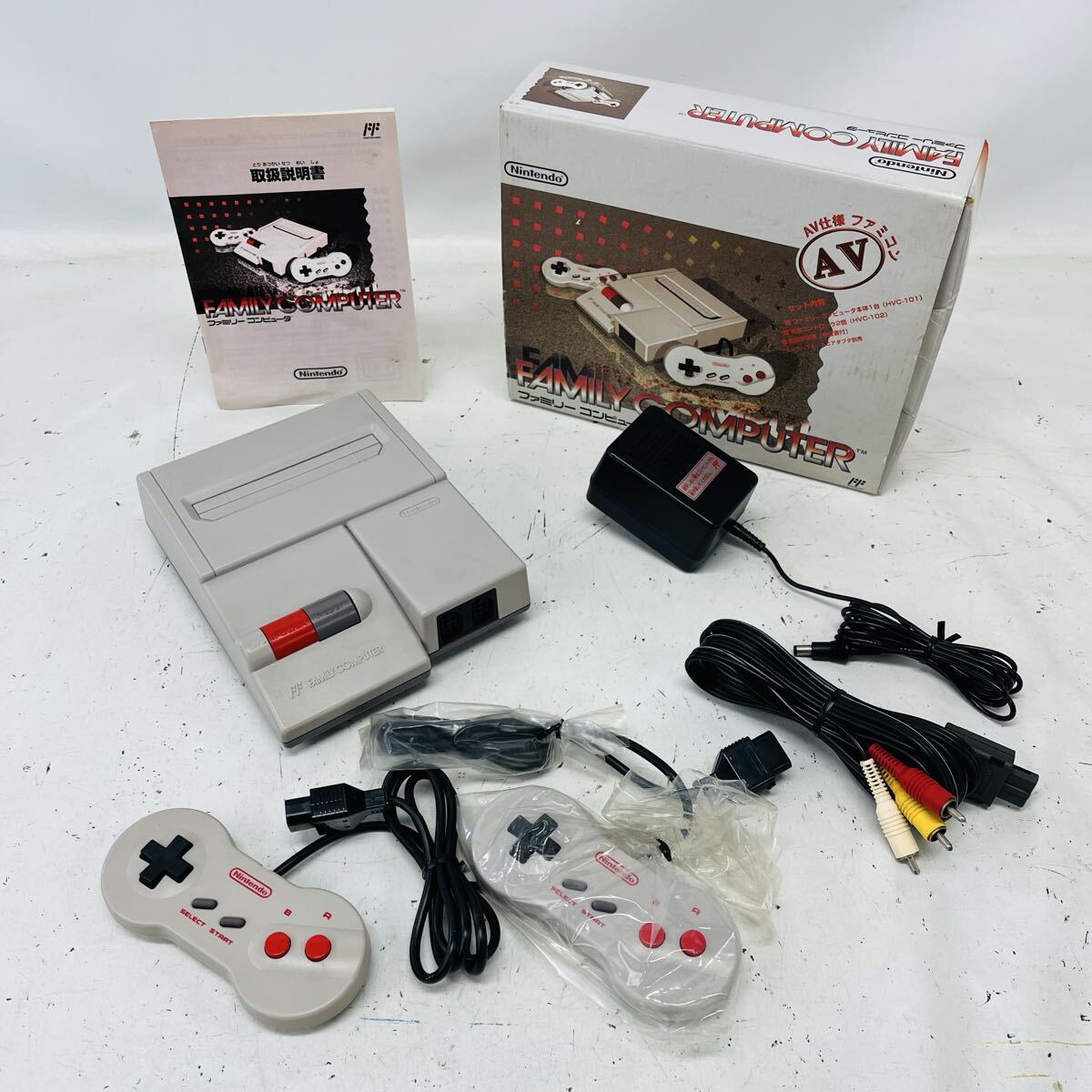NEW紅白機主機 AV端子連接
《AV版紅白機》(AV仕様ファミリーコンピュータ,通稱「新ファミコン」或「NEW FAMICOM」) 是任天堂於1993年12月1日在日本推出的改良型Family Computer(紅白機) 主機,型號為HVC-101。這款機型的誕生,象徵著任天堂試圖讓八位元世代的經典家用機以更現代化、更便利的形式延續壽命。雖然它問世的時間點,正值超級任天堂(Super Famicom)全盛時期,但憑藉復古價值與改良設計,仍成為許多遊戲收藏家與懷舊玩家心目中的經典硬體。
在設計理念上,AV版紅白機的「AV仕様」名稱來自其支援 Composite Video(複合影像)輸出 的功能。這一點在當時十分重要,因為早期的紅白機(HVC-001)僅能透過RF射頻線 連接電視,畫質模糊且聲音受干擾。而新版機種終於可使用 AV端子(黃紅白線) 直接輸出影像與音訊,畫面更清晰穩定,聲音也更乾淨,成為任天堂對經典硬體的一次大幅升級。這項改良也讓它得以與同世代其他主機(如Mega Drive、PC Engine)接軌,因此被命名為「AV仕様」。
機體外觀上,AV紅白機捨棄早期那種紅白配色、方正厚重的造型,改以淺灰與紅色按鍵 為基調,設計靈感來自北美地區的NES-101。整體外觀更輕薄,線條圓潤,主機體積縮小許多。控制器採用可拆卸式設計,並具備與超任(Super Famicom)相似的手感,A、B鍵排列角度調整後更易操作。以往舊型機的第二手把(2P)內建麥克風功能在新型中被取消,改以「下+A」或「Select」作為替代指令。控制器接頭與北美NES相同,因此部分第三方外設(如連射手把「Newホリコマンダー」)也可直接使用。
在硬體結構上,AV紅白機仍搭載Ricoh 2A03 CPU,維持與舊型完全相同的運算能力與遊戲相容性。所有原版卡帶、外部記憶裝置與週邊幾乎都能正常使用,唯獨因主機未內建RF輸出,因此若想使用傳統電視接法,需另購RF模組(HVC-103)。此外,由於採用AV端子輸出,聲音雖為單聲道,但透過混音電路輸出後的音質遠勝早期RF版本。玩家普遍認為,新紅白機的聲音「更清晰、層次更明顯」,甚至被部分音樂遊戲愛好者用來錄製遊戲BGM。
卡匣插槽設計也有所變化,改為自動開合式蓋板,雖然取消原本的「彈出機構(Eject)」設計,但操作更加流暢。任天堂同時取消內附電源變壓器與AV線,改為與超級任天堂共用配件,以降低成本。這使得AV紅白機成為一款價格實惠的「復刻式新品」,當年發售時的定位接近廉價機種,主要面向懷舊族群與新世代兒童市場。
然而,儘管設計出色、改良明顯,AV紅白機的壽命並不長。隨著次世代主機市場轉向超任與任天堂64,官方於 2003年9月25日 宣布正式停產,同時結束了「紅白機家族」二十年的歷史篇章。任天堂特別保留最後一台出廠的AV紅白機,編號 NH11033309,並在2003年至2004年間於「レベルX(Level X)」電玩展上展出,命名為「最後的Family Computer(ラスト・ファミリーコンピュータ)」。
在市場評價方面,雖非主流時代的焦點產品,但後來成為收藏市場中的稀有名機。它兼具紅白機的經典遊戲相容性與改良後的高品質輸出,因此被眾多復古遊戲愛好者視為「最完美版本的紅白機」。在日本與歐美的復古硬體論壇上,玩家普遍認為AV紅白機的影像輸出品質幾乎是原生FC遊戲的最佳呈現,特別是與現代顯示器搭配使用時仍能維持穩定輸出,成為懷舊玩家重溫8位元時代的理想機種。
綜觀其歷史,AV版紅白機不僅是紅白機的最終形態,更是任天堂在過渡至16位元時代之際,對經典家用機文化的一次致敬。它既代表1980年代電玩黃金時期的餘暉,也預示復古遊戲文化在未來的持續復興。
AV Specification Family Computer (Japanese: AV仕様ファミリーコンピュータ, commonly known as New Famicom or NEW Family Computer) was a redesigned version of Nintendo’s classic Family Computer (Famicom), released in Japan on December 1, 1993 under the model number HVC-101. This model represented Nintendo’s effort to modernize its legendary 8-bit console for a new era, offering a cleaner signal output and a sleeker design while maintaining full compatibility with its massive game library.
The term “AV Specification” came from its most notable improvement — the inclusion of composite video (AV) output. The original 1983 Famicom only connected to TVs through RF output, resulting in blurry visuals and noisy sound. The AV Famicom solved this by providing direct composite video and mono audio connections, a feature that was already standard in later consoles like the Sega Mega Drive and PC Engine. This change allowed for much sharper images and clearer sound, making the system far more convenient for both new users and retro enthusiasts.
Design-wise, the AV Famicom completely abandoned the red-and-white blocky look of the original in favor of a compact, gray chassis with red and dark-gray accents. Its appearance and layout were heavily inspired by the North American NES-101, also known as the “Top Loader.” The controllers were redesigned with a rounded, ergonomic shape, similar to those of the Super Famicom, and now featured detachable cables—a major upgrade over the fixed controllers of the original model. The A and B buttons were slightly repositioned for comfort, and while the second controller’s microphone feature was removed, its functions could be replicated using button combinations such as “Down + A” or “Select.”
Internally, the AV Famicom retained the Ricoh 2A03 CPU, meaning full backward compatibility with the entire Famicom cartridge library. Nearly all peripherals and accessories from the original could still be used, except for the built-in RF connection, which had been removed. Players who still wanted to use RF connections could purchase a separate RF Modulator (HVC-103). Despite having only mono sound output, the new audio circuitry produced much clearer tones than the original, avoiding the high-frequency loss common in RF transmissions. Many fans and audio hobbyists even considered the AV Famicom the “best-sounding” version of the console.
The cartridge slot was updated with an auto-opening lid that moved when inserting or removing cartridges, but the eject lever was eliminated—players now had to pull out cartridges manually. To reduce costs, the AC adapter and AV cables were sold separately, as the system was compatible with Super Famicom accessories. Nintendo positioned this model as a low-cost reissue of the Famicom, targeting nostalgic fans and younger players who wanted to experience 8-bit games at an affordable price.
Despite its thoughtful improvements, the AV Famicom’s production run was relatively short. As Nintendo shifted its focus to the Super Famicom and later the Nintendo 64, the company officially discontinued the AV Famicom on September 25, 2003. The final unit produced—serial number NH11033309—was preserved by Nintendo and later displayed at the “Level X” video game exhibition in 2003–2004 under the title “The Last Family Computer.”
In terms of reception, the AV Famicom was not a major commercial hit upon release, but it has since become a beloved collector’s item. Retro gaming enthusiasts often regard it as the definitive version of the Famicom, combining classic compatibility with modern AV output and improved durability. The console’s clean video signal makes it especially desirable for use with modern displays, and many consider it the best way to experience original Famicom titles as they were meant to be seen and heard.
Ultimately, the AV Specification Family Computer marked the final evolution of Nintendo’s first home console—a respectful tribute to the 8-bit era that changed gaming history. It stood at the crossroads between nostalgia and modernization, bridging the golden age of the 1980s with the enduring retro culture that continues to thrive decades later.
運費計算方式:
貨款滿1000元運費外加90元
貨款1000以下:買1件運費外加 60元,買2件運費外加 70元,
買3件運費外加 80元 ,買4件運費外加 90元
貨到付款外加30元手續費
外島及大陸地區運費另計
付款方式:
線上刷卡:本站採用Paypal線上刷卡
虛擬帳號匯款:屬於您專屬的虛擬帳戶,方便站長查帳使用,本站強力推薦
實體ATM匯款:請將匯款帳號記錄下來至各大銀行ATM提款機轉帳
超商條碼繳費:請列印本站提供的條碼至四大超商繳費
線上轉帳:透過玉山銀行線上ATM轉帳(此系統只支援IE瀏覽器)
貨到付款:本站採用黑貓宅急便貨到付款
其他注意事項:
如需購買線上點數卡請直接跟站長連絡,本站不提供點數卡的線上付款
-
NEW紅白機主機 AV端子連接
- 定 價: 7,000円
- 售 價: 5999.00
- 庫存量: 0 套
- 已賣出: 0 套
 人氣指數: 0.2 / 6 顆星
人氣指數: 0.2 / 6 顆星

